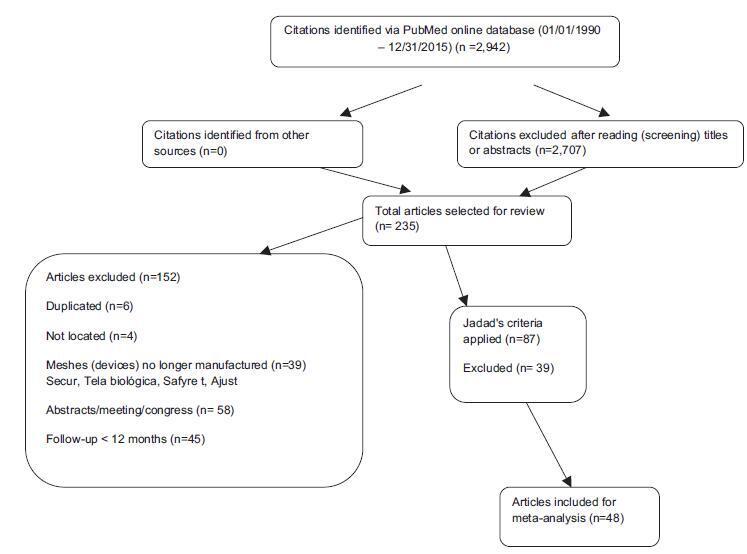Home
Summary
Revista Brasileira de Ginecologia e Obstetrícia. 08-01-2018;40(8):477-490
To compare surgical treatments for stress urinary incontinence in terms of efficiency and complications.
We searched the MEDLINE and COCHRANE databases using the terms stress urinary incontinence, surgical treatment for stress urinary incontinence and sling. Selection of Studies Forty-eight studies were selected, which amounted to a total of 6,881 patients with scores equal to or higher than 3 in the Jadad scale.
Each study was read by one of the authors, added to a standardized table and checked by a second author. We extracted data on intervention details, follow-up time, the results of treatment and adverse events.
Comparing retropubic versus transobturator slings, the former was superior for both objective (odds ratio [OR], 1.27; 95% confidence interval [CI], 1.05-1.54) and subjective (OR, 1.23; 95% CI, 1.02-1.48) cures. Between minislings versus other slings, there was a difference favoring other slings for subjective cure (OR, 0.58; 95% CI, 0.39- 0.86). Between pubovaginal sling versus Burch surgery, there was a difference for both objective (OR, 2.04; 95% CI, 1.50-2.77) and subjective (OR, 1.64; 95% CI, 1.10-2.44) cures, favoring pubovaginal sling. Therewas no difference in the groups: midurethral slings versus Burch, pubovaginal sling versus midurethral slings, transobturator slings, minislings versus other slings (objective cure). Retropubic and pubovaginal slings are more retentionist. Retropubic slings have more bladder perforation, and transobturator slings, more leg and groin pain, neurological lesion and vaginal perforation.
Pubovaginal slings are superior to Burch colposuspension surgery but exhibit more retention. Retropubic slings are superior to transobturator slings, with more adverse events. Other slings are superior to minislings in the subjective aspect. There was no difference in the comparisons between midurethral slings versus Burch colposuspension surgery, pubovaginal versus midurethral slings, and inside-out versus outside-in transobturator slings.


Summary
Revista Brasileira de Ginecologia e Obstetrícia. 08-01-2018;40(8):477-490
To compare surgical treatments for stress urinary incontinence in terms of efficiency and complications.
We searched the MEDLINE and COCHRANE databases using the terms stress urinary incontinence, surgical treatment for stress urinary incontinence and sling. Selection of Studies Forty-eight studies were selected, which amounted to a total of 6,881 patients with scores equal to or higher than 3 in the Jadad scale.
Each study was read by one of the authors, added to a standardized table and checked by a second author. We extracted data on intervention details, follow-up time, the results of treatment and adverse events.
Comparing retropubic versus transobturator slings, the former was superior for both objective (odds ratio [OR], 1.27; 95% confidence interval [CI], 1.05-1.54) and subjective (OR, 1.23; 95% CI, 1.02-1.48) cures. Between minislings versus other slings, there was a difference favoring other slings for subjective cure (OR, 0.58; 95% CI, 0.39- 0.86). Between pubovaginal sling versus Burch surgery, there was a difference for both objective (OR, 2.04; 95% CI, 1.50-2.77) and subjective (OR, 1.64; 95% CI, 1.10-2.44) cures, favoring pubovaginal sling. Therewas no difference in the groups: midurethral slings versus Burch, pubovaginal sling versus midurethral slings, transobturator slings, minislings versus other slings (objective cure). Retropubic and pubovaginal slings are more retentionist. Retropubic slings have more bladder perforation, and transobturator slings, more leg and groin pain, neurological lesion and vaginal perforation.
Pubovaginal slings are superior to Burch colposuspension surgery but exhibit more retention. Retropubic slings are superior to transobturator slings, with more adverse events. Other slings are superior to minislings in the subjective aspect. There was no difference in the comparisons between midurethral slings versus Burch colposuspension surgery, pubovaginal versus midurethral slings, and inside-out versus outside-in transobturator slings.



Search
Search in:
Breast Breast neoplasms Cesarean section Endometriosis Infertility Maternal mortality Menopause Obesity Postpartum period Pregnancy Pregnancy complications Pregnant women Prenatal care prenatal diagnosis Prevalence Quality of life Risk factors Ultrasonography Uterine cervical neoplasms Women's health
